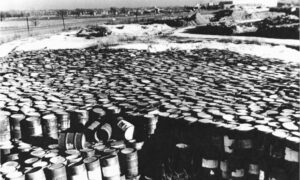8:00
News Story
Signs warning of radioactive waste to be installed along Missouri’s Coldwater Creek this fall
The signs released by the U.S. Army Corps of Engineers warn of ‘low-level radioactive materials present’ near the suburban St. Louis creek

An undated photo from the 1980s, of two teenagers stepping on rocks and wooden planks on Coldwater Creek. The photo is from a scrapbook kept by Sandy Delcoure, who lived on Willow Creek in Florissant and donated the scrapbook to the Kay Drey Mallinckrodt Collection (State Historical Society of Missouri, Kay Drey Mallinckrodt Collection, 1943-2006).

Federal officials plan to post warning signs along a contaminated suburban St. Louis creek where generations of children were exposed to radioactive material.
Coldwater Creek, which winds between homes and parks in St. Louis County for 14 miles before meeting the Missouri River, is plagued with nuclear waste left over from World War II. For decades, families had no idea the danger it posed to the children who played along its banks and swam in its waters.
More than six years ago, a federal study found residents who live near the creek or regularly came in contact with its waters faced a higher risk of certain cancers.
Still, the U.S. Army Corps of Engineers, which is cleaning up the creek, did not post signs warning visitors of its danger.
But this fall, the Corps plans to post signs along Coldwater Creek, warning of the “low-level radioactive materials present.” In a Facebook post, the Corps’ St. Louis branch said the first of the signs will be placed in mid or late November.
 The signs, marked with an eye-catching cautionary yellow border, instruct readers not to dig near the creek but say the waste doesn’t pose a health threat as long as the ground is left undisturbed. Corps officials had previously released a draft of a warning sign with a blue banner that said there “may” be radioactive materials near.
The signs, marked with an eye-catching cautionary yellow border, instruct readers not to dig near the creek but say the waste doesn’t pose a health threat as long as the ground is left undisturbed. Corps officials had previously released a draft of a warning sign with a blue banner that said there “may” be radioactive materials near.
Dawn Chapman, who co-founded Just Moms STL to advocate for St. Louis-area families harmed by radioactive waste, said the group was happy with the new signs and thinks they’ll save lives.
“But also, we’re so sad because we know people that are hurt that probably wouldn’t have been if they were up a long time ago,” Chapman said.
The Missouri Coalition for the Environment, which has advocated for signs along Coldwater Creek for more than 25 years, said in a press release that the signs mark a “step in the right direction,” but don’t fully acknowledge the danger present along the creek.
The sign doesn’t acknowledge areas where contamination may be at the surface, doesn’t use the universal symbol for radioactive material and may confuse visitors by referring to the material as “low-level,” the Missouri Coalition for the Environment said.
St. Louis has struggled with radioactive contamination since World War II. Uranium used in the development of the atomic bomb was refined in downtown St. Louis. After the war, the waste was dumped at the airport and, later, a nearby property — both along Coldwater Creek. The waste was further refined to extract valuable metals and the remaining material illegally dumped in the West Lake Landfill, where it remains today.
The Corps is leading the cleanup of Coldwater Creek and the Environmental Protection Agency is overseeing work at the West Lake Landfill.
Last summer, The Independent, MuckRock and The Associated Press found that, for decades, federal officials and companies handling the waste downplayed or failed to investigate the true danger of the material. Since the revelation, U.S. Sen. Josh Hawley and members of Congress from Missouri — along with southwestern states affected by nuclear weapons testing — have been fighting for compensation for victims of radioactive waste exposure.
To do so, Hawley and U.S. Sen. Ben Ray Luján, a Democrat from New Mexico, proposed expanding the Radiation Exposure Compensation Act, originally passed in 1990 to compensate uranium miners and those who were exposed to atomic bomb testing in parts of Nevada, Utah and Arizona.
Hawley and Luján’s bill would expand the program to remaining parts of Arizona, Nevada and Utah and provide coverage for the first time in Colorado, Idaho, Montana, New Mexico and Guam, where residents were exposed to radiation from weapons tests. It would also expand coverage to those exposed in Missouri, Tennessee, Alaska and Kentucky.
The legislation twice passed the Senate, but was never heard on the floor of the U.S. House of Representatives. When the House failed to pass a RECA expansion or extension in June, the legislation expired.
Hawley said on the U.S. Senate floor last week that the legislation is being “attacked” and exposure victims labeled as “greedy and unthankful and ungrateful and undeserving of any help or recognition or thanks from this country.”
Hawley called on members of Congress to “stand up and be counted” and support the legislation.
“We will not stop fighting,” he said. “We will not stop working until every nuclear radiation victim who has given their life and health for the support of this nation is thanked and compensated.”
Chapman said RECA advocates are returning to Washington, D.C., next week to advocate for the expansion. She said she believes Congress will act on RECA sometime in the coming months.
“I feel very close,” Chapman said. “We feel like this could be it for us next week.”
YOU MAKE OUR WORK POSSIBLE.
Our stories may be republished online or in print under Creative Commons license CC BY-NC-ND 4.0. We ask that you edit only for style or to shorten, provide proper attribution and link to our website. AP and Getty images may not be republished. Please see our republishing guidelines for use of any other photos and graphics.




